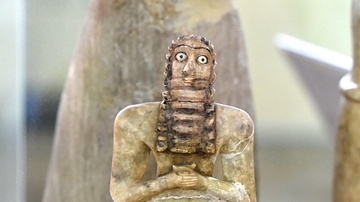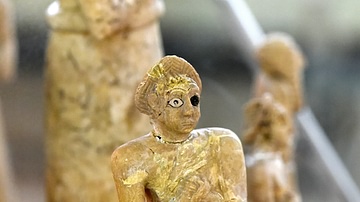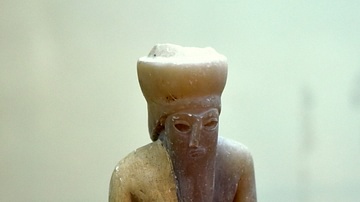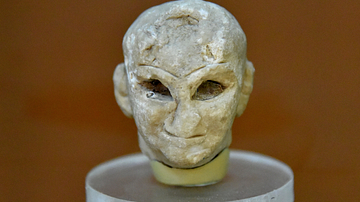Illustration
Amongst the most famous statues from Tell Asmar are these two standing male and female ones, which were made of veined gypsum. They have a wide-eyed gaze and hold a cup with their hands. The man is bare-chested and wears a flounced kilt while the woman wears a flounced garment with a bare right shoulder. The eye-balls were made of shells and the irises were made of black limestone; both were held in position by bitumen. The hair and beard were painted with bitumen. If you zoom in on the image, on the front of the base of the male statue, you will see an antithetical group of two couchant gazelles with plants across the background; between them, there is a bird with spreading wings. Once again, if you zoom in, you will find a groove on the base of the female statue, besides the left leg, to receive a miniature figure (its legs have only survived). Both statues were excavated by the Oriental Institute of the University of Chicago in early 1930s CE. From the Square Temple of Abu at Tell Asmar (ancient Eshnunna), in modern-day Diyala, Iraq. Early Dynastic period, c. 2600 BCE. They are on display within a single glass case in the Sumerian Gallery at the Iraq Museum in Baghdad, Republic of Iraq.
About the Author
Cite This Work
APA Style
Amin, O. S. M. (2019, March 21). Sumerian Worshipers from Tell Asmar at the Iraq Museum. World History Encyclopedia. Retrieved from https://www.worldhistory.org/image/10266/sumerian-worshipers-from-tell-asmar-at-the-iraq-mu/
Chicago Style
Amin, Osama Shukir Muhammed. "Sumerian Worshipers from Tell Asmar at the Iraq Museum." World History Encyclopedia. Last modified March 21, 2019. https://www.worldhistory.org/image/10266/sumerian-worshipers-from-tell-asmar-at-the-iraq-mu/.
MLA Style
Amin, Osama Shukir Muhammed. "Sumerian Worshipers from Tell Asmar at the Iraq Museum." World History Encyclopedia. World History Encyclopedia, 21 Mar 2019. Web. 16 Apr 2025.






![Head of a Sumerian Male from Tell Asmar [Right Side]](https://www.worldhistory.org/img/c/p/360x202/9687.jpg?v=1599123604)

![Head of a Sumerian Male from Tell Asmar [Left Side]](https://www.worldhistory.org/img/c/p/360x202/9688.jpg?v=1599124502)